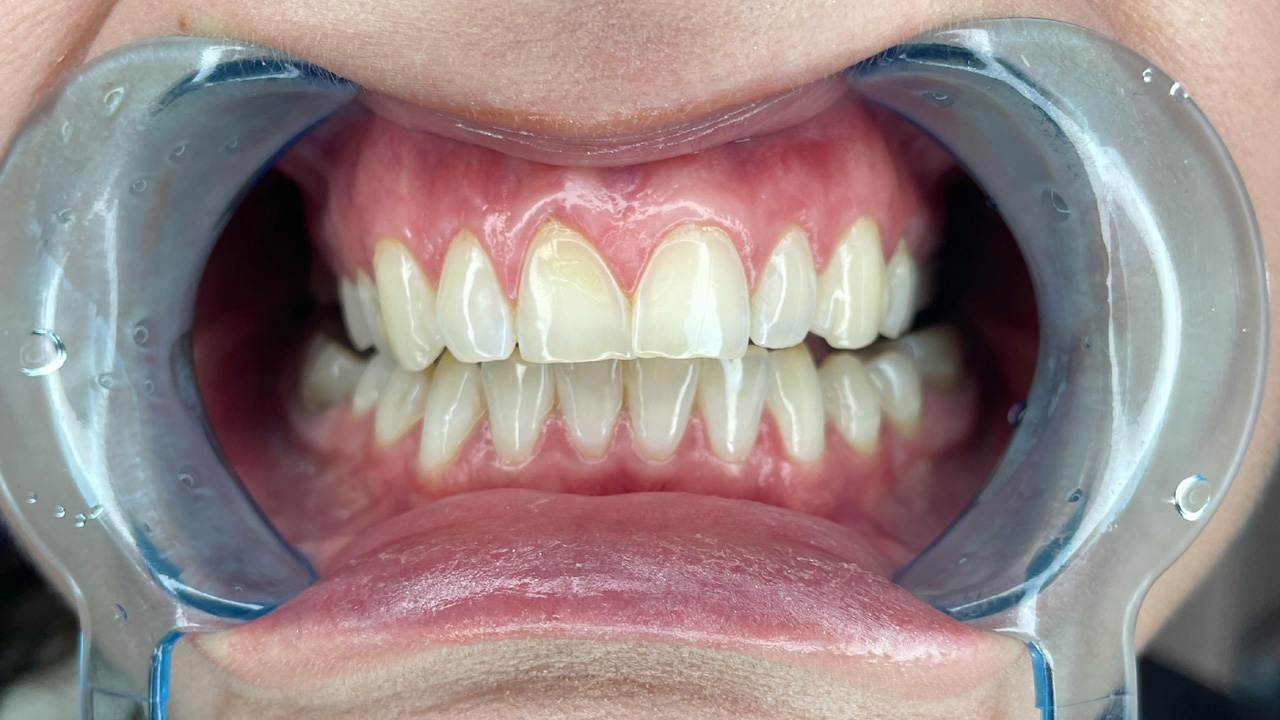During a deep dental cleaning, you’ll undergo a procedure known as scaling and root planing. This process targets plaque and tartar below the gum line, aiding in reducing pocket depth for better oral health. Local anesthesia guarantees your comfort throughout the treatment. The dentist divides the cleaning into two appointments, one for each side of your mouth, for thoroughness. Scaling removes plaque, root planing smooths rough spots on tooth roots, leading to improved oral hygiene. Expect minor post-procedure sensitivity, soreness, or bleeding gums that can be managed with proper care. The next steps in your dental care regimen will address these concerns and support your oral health further.
Deep Dental Cleaning Overview
When it comes to maintaining good oral health, understanding the overview of extensive dental cleaning, also known as scaling and root planing, is important. This procedure is necessary for patients with gum disease as it aims to remove plaque and tartar from below the gum line, preventing tooth loss and infections. Deep cleaning involves two appointments to address each side of the mouth, utilizing local anesthesia to numb the gums for comfort. By reducing pocket depth between teeth and gums caused by gum disease, deep cleaning promotes better oral health outcomes. Post-treatment care is crucial and includes monitoring the healing process, practicing good oral hygiene, and attending follow-up appointments as recommended by your dental care provider. By adhering to these post-care instructions, you can ensure the success of the deep cleaning procedure and maintain excellent oral health in the long run.
Process of Deep Teeth Cleaning
During the process of thorough teeth cleaning, your dentist will perform scaling to meticulously remove stubborn plaque and tartar that has accumulated below the gum line. This deep cleaning procedure involves using special tools to scrape off these deposits, ensuring a thorough cleaning of your teeth and gums. Additionally, root planing may be conducted to smooth rough spots on the tooth roots, preventing bacteria buildup and promoting gum health. In some cases, antibiotic treatment might be recommended to kill bacteria and aid in the healing process. Local anesthesia is commonly used to numb the gums during the procedure, ensuring your comfort throughout. Typically, the deep cleaning process is divided into two appointments, one for each side of the mouth, allowing for a thorough cleaning experience. By addressing plaque, gingivitis, and bacteria buildup, deep teeth cleaning aims to improve your oral health and prevent further dental issues.
Frequency of Deep Cleaning
For individuals with advanced gum disease, the frequency of deep cleaning sessions is a critical aspect of maintaining peak oral health. Here are some key points to keep in mind regarding the best timing for deep cleaning:
- Regular Schedule: Deep cleaning is typically recommended every 6 months to 1 year for patients with advanced gum disease.
- Deep Pockets: Patients with deep pockets (4mm or more) may require more frequent deep cleanings to maintain gum health.
- Oral Hygiene: Good oral hygiene practices post-deep cleaning can reduce the need for more frequent treatments.
- Dental Check-Ups: Regular dental check-ups are essential to monitor gum health and determine the necessity for deep cleaning.
Disadvantages of Deep Cleaning
Experiencing temporary sensitivity, bleeding gums, or soreness post-procedure are common drawbacks of deep cleaning. These risks are often manageable but can cause discomfort for a short period after the treatment. Additionally, the costs for deep cleaning procedures can range from $150 to $350 per quadrant without insurance coverage. To make deep cleaning more affordable, it is advisable to discuss payment plans or options with your dentist beforehand. Following proper post-treatment care instructions is crucial to minimize any disadvantages associated with deep cleaning. Despite these potential drawbacks, the benefits of deep cleaning in preventing gum disease progression and tooth loss outweigh the temporary discomfort and costs. It is essential to consider the long-term advantages of maintaining good oral health through deep cleaning to prevent more serious issues in the future. Remember, the short-term inconveniences are a small price to pay for the significant benefits that deep cleaning can offer in preserving your oral well-being.
Experiencing temporary sensitivity, bleeding gums, or soreness post-procedure are common drawbacks of deep cleaning. These risks are often manageable but can cause discomfort for a short period after the treatment. Moreover, deep cleanings are essential treatments for gum disease. Additionally, the costs for deep cleaning procedures can range from $150 to $350 per quadrant without insurance coverage. To make deep cleaning more affordable, it is advisable to discuss payment plans or options with your dentist beforehand. Following proper post-treatment care instructions is crucial to minimize any disadvantages associated with deep cleaning. Despite these potential drawbacks, the benefits of deep cleaning in preventing gum disease progression and tooth loss outweigh the temporary discomfort and costs. It is essential to consider the long-term advantages of maintaining good oral health through deep cleaning to prevent more serious issues in the future. Remember, the short-term inconveniences are a small price to pay for the significant benefits that deep cleaning can offer in preserving your oral well-being.
Tooth Loss Concerns Post-Cleaning
Tooth loss is a valid concern for many individuals following a deep dental cleaning. Here are some key points to keep in mind regarding tooth loss post-cleaning:
- Prevention of Tooth Loss: Deep dental cleanings are aimed at averting tooth loss by addressing gum disease, which is a leading cause of teeth becoming loose and falling out.
- Gum Reattachment: Initially, you may experience some loosening of teeth due to gaps between your gums and teeth. However, over time, the gums should reattach, securing the teeth in place.
- Reduced Inflammation: Deep cleaning helps decrease inflammation in the gum tissues, which is vital for stabilizing teeth and preventing further damage that could lead to tooth loss.
- Importance of Follow-Up: Regular follow-up appointments and maintaining good oral hygiene practices post-cleaning are essential. These measures can markedly reduce the risk of teeth falling out and help guarantee the long-term health of your teeth and gums.
Impact on Gum Disease Progression
Deep dental cleanings play a vital role in managing gum disease progression. By targeting plaque and bacteria below the gumline, this procedure can halt the advancement of gum disease. It is an essential treatment to reduce inflammation, prevent further damage, and maintain peak gum health.
Gum Disease Progression
As gum disease progresses, it can evolve from the initial stage of gingivitis to more severe conditions like periodontitis and advanced periodontitis. This progression can have significant implications for your oral health. Here are some key points to keep in mind:
- Untreated gum disease: Ignoring gum disease can lead to advanced gum disease, causing tooth loss, infections, and even damage to the bones that support your teeth.
- Deep dental cleaning: Regular deep cleanings can help slow down or halt the progression of gum disease, preventing further damage to your oral health.
- Monitoring gum disease: Keeping track of the progression of gum disease is essential for maintaining good oral health and preventing complications.
- Preventive measures: By undergoing deep dental cleanings and following good oral hygiene practices, you can improve your gum health and reduce the risk of gum disease advancement.
Understanding the stages of gum disease and the importance of preventive care can help you take proactive steps towards maintaining a healthy smile.
Treatment Impact
An important aspect of addressing gum disease progression is the impact of treatment on slowing or halting its advancement. Deep teeth cleaning plays a key role in this process by targeting the root cause of gum disease. By removing plaque and tartar that have accumulated below the gumline, the procedure helps reduce gum inflammation, bleeding, and the depth of periodontal pockets. This not only prevents further damage to the gums and teeth but also promotes gum reattachment to the tooth roots. As a result, deep cleaning can greatly improve oral health and decrease the risk of tooth loss associated with advanced gum disease. For individuals with periodontal disease, regular deep cleanings are essential to maintaining healthy gums and preventing the progression of periodontal disease. By undergoing this important intervention, patients can enjoy the long-term benefits of healthier gums and teeth.
Pain Expectations During Cleaning
During a deep dental cleaning, it is common to have concerns about potential pain and discomfort. Here’s what you can expect regarding pain during the cleaning:
- Local Anesthetic: Your dentist will use a local anesthetic to minimize any pain or discomfort during the deep cleaning procedure.
- Soreness: It’s normal to experience some soreness in your gums and teeth after the cleaning, but this should subside within a few days.
- Sensitivity: You may notice increased sensitivity to hot and cold temperatures post-cleaning, which can be managed with special sensitivity toothpaste.
- Bleeding: Minor bleeding during and after the cleaning is common. Proper post-cleaning care, such as gentle brushing and rinsing with saltwater, can help improve this issue.
Difference From Regular Cleaning
When comparing deep dental cleaning to regular cleaning, it is crucial to consider the differences in techniques used. Regular cleaning primarily focuses on maintaining oral health above the gum line, while deep cleaning targets plaque and tartar below the gum line. Deep cleaning involves scaling and root planing to address advanced gum disease, offering a more intensive approach than the preventive maintenance of regular cleanings.
Deeper Cleaning Techniques
To distinguish deeper cleaning techniques from regular dental cleanings, understanding that deep cleaning involves a more thorough removal of plaque and tartar below the gumline is key, targeting areas that traditional cleanings may not reach effectively. Here are the key aspects of deeper cleaning techniques:
- Scaling: This process involves the removal of plaque and tartar from the tooth surfaces, including below the gumline, using specialized instruments.
- Root Planing: This step focuses on smoothing out rough areas on the tooth roots to prevent bacteria from reattaching and to promote gum reattachment to the teeth.
- Gum Disease Treatment: Deep cleaning is essential for addressing advanced gum disease by cleaning deep gum pockets that have formed due to infection.
- Oral Health Maintenance: Deep cleaning helps prevent further progression of gum disease, tooth loss, and supports overall oral health.
These techniques are crucial for managing gum disease effectively and preserving your oral health.
Advanced Gum Disease Care
As you move beyond the world of regular dental cleanings, the focus shifts towards a more specialized approach known as deep dental cleaning, specifically tailored for addressing advanced gum disease. Advanced gum disease care involves a deep cleaning procedure that targets plaque and tartar below the gumline through scaling and root planing. This intensive treatment aims to address periodontal pockets and prevent tooth loss by halting the progression of gum disease. Symptoms like bleeding gums, bad breath, and loose teeth often indicate the need for deep dental cleaning to effectively combat advanced gum disease. Unlike regular cleanings that primarily focus on the surface of teeth, deep cleaning is a thorough intervention designed for patients with significant gum disease. By promoting gum reattachment to the teeth and addressing underlying issues, deep cleaning plays an essential role in maintaining oral health and preventing further complications associated with advanced gum disease.
Preventative Maintenance Contrast
For those seeking to understand the difference between deep dental cleaning and regular cleanings, it is important to recognize the preventive maintenance contrast that sets them apart. Here are the key differences to help you grasp the significance of deep cleaning for your oral health:
- Regular cleaning focuses on maintaining oral health by removing plaque and tartar from the visible surfaces of your teeth.
- Deep cleaning goes beyond the surface to address plaque and bacteria that have accumulated below the gum line.
- Deep cleaning involves scaling and root planing, a process that removes calculus and tartar from the roots of your teeth.
- Unlike regular cleanings, deep cleaning is essential for preventing gum disease progression, reducing inflammation, preventing tooth loss, and improving overall oral health.
Understanding these distinctions can help you make informed decisions about your dental care and guarantee the long-term health of your teeth and gums.

Importance of Deep Cleaning
Ensuring your oral health is in top shape involves more than just regular brushing and flossing. Deep cleaning plays a pivotal role in maintaining healthy gums and teeth. By removing plaque and tartar below the gum line, deep cleaning helps prevent gum disease progression, reducing the risk of tooth decay and infection. Additionally, this procedure aids in preventing bad breath, gum recession, and shifting teeth.
Deep cleaning promotes gum reattachment to tooth roots, safeguarding the supporting structures of your teeth. Regular deep cleanings can notably improve gum health, potentially eliminating the need for more invasive dental treatments. It is an essential part of oral health maintenance, ensuring that your gums stay healthy and your smile remains bright. Don’t overlook the significance of deep cleaning in your oral care routine; it can make a remarkable difference in the long-term health of your gums and teeth.
Research and Resources on Deep Cleaning
When examining the research and resources related to deep dental cleaning, it is important to note that systematic reviews and meta-analyses consistently emphasize its effectiveness in managing periodontal disease. Microbiologic testing further shows the positive influence of deep cleaning in reducing inflammation and pocket depth, supporting its clinical applications. Experts like Dr. Mark Burhenne, DDS, stress evidence-based treatments, with deep dental cleaning playing a key role in enhancing overall gum health. Furthermore, the significance of regular follow-up visits for maintenance after deep cleaning is vital for long-term oral health Scaling & Root Planing.
Research Findings
Amidst the wealth of research and resources available on deep dental cleaning, it is evident that systematic reviews and meta-analyses consistently affirm the effectiveness of this procedure in the treatment of periodontal disease.
- Deep dental cleaning, also known as scaling and root planing (SRP), has shown positive outcomes in reducing bacteria levels and inflammation in the gums.
- Evidence-based treatments for chronic periodontitis have demonstrated significant improvements in gum health and reduction of pocket depth through deep dental cleaning procedures.
- Microbiologic testing supports the efficiency of deep cleaning in targeting harmful bacteria, thereby contributing to overall oral health.
- Professionals in the field, like Dr. Mark Burhenne, DDS, and functional dentists, emphasize the importance of deep dental cleaning for maintaining healthy teeth, preventing gum disease progression, and enhancing overall oral health.
These findings underscore the significance of deep dental cleaning as an essential component in managing periodontal disease and promoting ideal oral health.
Clinical Applications
Research and resources on profound dental cleaning provide valuable insights into its clinical applications for treating periodontal disease. Profound cleaning, also known as dental scaling and root planing, plays an essential role in improving gum health by removing plaque and tartar from below the gumline. Studies have shown that profound cleaning is an evidence-based treatment for chronic periodontitis, a severe form of gum disease. Microbiologic testing has demonstrated positive outcomes following profound cleaning procedures, highlighting its effectiveness in combating periodontal issues. Dr. Mark Burhenne, a respected functional dentist with over 35 years of experience, emphasizes the importance of profound cleaning for maintaining best oral health. By following evidence-based practices and recommendations from professionals like Dr. Burhenne, individuals can address periodontal disease effectively through profound dental cleaning, promoting healthier gums and overall oral well-being.
Professional Recommendations
As you explore the world of deep dental cleaning, it becomes apparent that professional recommendations play a pivotal role in guiding individuals towards best oral health. When seeking guidance on deep cleaning, consider the following:
- Evidence-Based Practices: Research supports the effectiveness of deep dental cleaning (SRP) in treating periodontal disease, emphasizing the importance of evidence-based approaches for best results.
- Microbiologic Testing: Positive outcomes in reducing gum inflammation and pocket depth have been observed with deep cleaning, highlighting the significance of thorough testing to track progress.
- Chronic Periodontitis Treatment: Deep dental cleaning is recommended for chronic periodontitis to enhance gum health and prevent disease advancement, underlining the critical role of regular cleanings in managing this condition.
- Professional Guidance: Dr. Mark Burhenne, DDS, and functional dentists offer valuable insights and evidence-based resources for maintaining dental health, providing expert advice on preventing and healing issues related to deep cleaning.
Frequently Asked Questions
Is a Dental Deep Cleaning Painful?
Deep dental cleanings aren’t usually painful since local anesthetic numbs your gums. Some soreness post-treatment is normal. Use a soft toothbrush, sensitive toothpaste, and avoid extreme temps for comfort. Sensitivity to hot/cold should improve as gums heal.
How Long Does It Take to Recover From Deep Teeth Cleaning?
Recovery time varies after deep teeth cleaning. Expect mild discomfort and gum tenderness for a few days to a week. Follow aftercare instructions for a smooth healing process. Contact your dentist for persistent pain or swelling.
What Are the Disadvantages of Deep Cleaning Teeth?
When considering deep teeth cleaning, be aware of potential disadvantages like cost implications, gum and tooth sensitivity, and rare risks such as infection. Discuss anesthesia options with your dentist, follow aftercare instructions, and attend follow-up appointments for best recovery.
What Happens During Dental Deep Cleaning?
During a dental deep cleaning, the dentist uses tools for scaling and root planing to remove plaque, prevent gum disease, and promote gum reattachment. Aftercare is essential for maintenance. Regular cleanings are recommended. Insurance may cover costs. Your dentist will advise on prevention and care.


